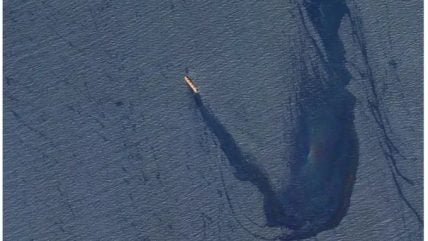
A Houthi attack on a UK-owned bulk carrier has left an “18-mile oil slick” in the Gulf of Aden, the US Central Command (CENTCOM) said on Saturday (24 February), threatening an “environmental disaster” and casting doubt over already record-high freight rates.
Amid ongoing attacks by the Yemen-based Houthi militants on vessels in the Red Sea region, rates on ocean freight between Europe, North America and Asia have risen drastically since Houthi attacks began at the end of November.
Freight rates between Asia and Northern Europe – which often traverse the Suez Canal and Bab al-Mandab Strait – rose from $1,500 per 40-foot container in mid-December to roughly $5,500 by late January, Freightos data shows.
Prices from Asia to the east coast of North America climbed from $2,500 to nearly $6,800 by mid-February.
Can freight rates decline if Houthi attacks persist?
This rise peaked in January, which Judah Levine, Freightos’ head of research, says is attributable to both Houthi attacks and seasonal demand in China.
“As the first weeks of the diversions coincided with the lead up to the Lunar New Year holiday in China, the seasonal increase in demand for ocean freight created additional urgency and helped push ocean container rates up sharply in January”, Levine tells Ship Technology.
How well do you really know your competitors?
Access the most comprehensive Company Profiles on the market, powered by GlobalData. Save hours of research. Gain competitive edge.

Thank you!
Your download email will arrive shortly
Not ready to buy yet? Download a free sample
We are confident about the unique quality of our Company Profiles. However, we want you to make the most beneficial decision for your business, so we offer a free sample that you can download by submitting the below form
By GlobalDataHowever, the last few weeks have seen prices to Europe decline by 17% with “the pre-Lunar New Year increase in demand behind us” and “more carrier strategies to stabilise operations”, says Levine.
Rates to North America have also eased in the last week, albeit insignificantly.
“Prices are likely to continue to ease as ocean freight enters its slow season, but should remain above normal levels while the diversions continue”, Levine adds.
Houthi attacks continue to squeeze freight rates, even if the worst disruption on Red Sea freight rates has already passed, according to Daniel Harlid, senior credit officer at finance risk analysts Moody’s.
“Our base case is still that freight rates will decrease as new capacity enters the market; there already signs of freight rates that have peaked,” Harlid tells Ship Technology. “Overall, we note that despite military presence in the Red Sea by various western countries, carriers are still choosing to use the alternative route around the Cape of Good Hope.”
What has happened to the Rubymar?
The Rubymar was transporting 41,000 tonnes of fertiliser near the Bab al-Mandab Strait when the Houthis hit the vessel with two anti-ship ballistic missiles.
One hit the side of the Belize-flagged ship near its engine room, while the other hit the vessel’s deck.
Despite Houthi claims that the carrier had sunk, reports have surfaced that the crew abandoned the vessel as it was towed to Djibouti.
Data from MarineTraffic shows the Rubymar’s last active position eight days ago (19 February) was just off Yemen’s south-western coastline, where it was en route to Varna, Bulgaria.
CENTCOM’s environmental warnings point to the damaging ocean acidification of the Rubymar’s fertilisers mixing with local marine ecosystems.
Environmental concerns around the Red Sea crisis have intensified recently as research shows emissions from diverted ship routes have increased by at least 30%.
Spokesperson Yayha Sare’e also said the Houthis had targeted the UK-owned Islander carrier on 22 February and US-owned Torm Thor oil tanker on Saturday (24 February) with “a number of appropriate naval missiles”.
CENTCOM clarified that the attack on the Torm Thor caused “no damage or injuries”.
These attacks mark the latest escalation in the Houthis’ military campaign against what the group claims are Israeli-affiliated ships in the Red Sea.
The US and UK have since deployed a naval taskforce in the region and multiple air strikes on Yemen, the most recent on Sunday (25 February).







